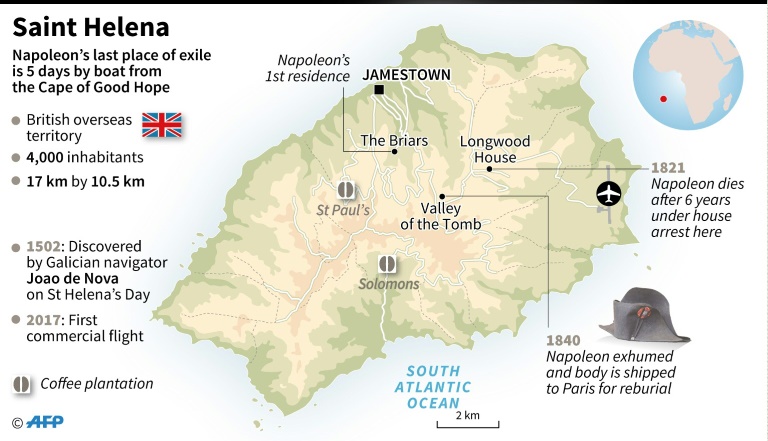Godongwana consents to court order against VAT increase
The British island of just over 4,000 people, where the locals are called “Saints”, is known best as the rocky outcrop where French emperor Napoleon Bonaparte saw out his final days.
Now, after five years of construction, controversy and embarrassing delays due to high winds, an airport built at a cost of £285 million (318 million euros) will welcome its first routine flight from Johannesburg.

Saint Helena is a remot British territory of some 4,000 inhabitants
The volcanic tropical island itself measures just 122 square kilometres (47 square miles) and is located almost exactly halfway between Africa and South America.
Its isolated location meant it was chosen as a place of exile for those who suffered defeat at the hands of the British, with Napoleon held there from 1815 until his death in 1821.
Several thousand Boer prisoners of war were also detained there at the start of the 20th century.
Until Saturday, St. Helena was one of the world’s most inaccessible locations.
It has been only reachable by sea, a five-day voyage from Cape Town aboard a Royal Mail vessel that chugs along at a speed of just 15 knots (28 kilometres an hour).
Every three weeks, the RMS St. Helena has been the islanders’ link to the outside world, bringing a cargo of food, post, visitors and vehicles.
– Major engineering challenge –
The new flight route, via Windhoek in Namibia, will mean that the island will be reachable by air from South Africa in just six hours.
Authorities have issued a list of the best vantage points to watch the arrival of AirLink flight 8131.
“We are very excited that is finally happening,” said Helena Bennett of the St. Helena tourism office.
The airport has been a colossal civil engineering challenge.
The island had no suitable flat surface to construct the necessary 1,950 metre-long airstrip.
Engineers were forced to chip away a mountain peak and fill in a valley to create enough of an even surface.
The runway is located on a breathtaking mountain just 300 metres from the sea.
Because of high winds, Comair abandoned plans to operate the route with a Boeing 737, paving the way for AirLink’s smaller Embraer 190 jet.
– High winds setback –
The winds meant that the airport could not be opened in 2016 as originally planned with a ribbon-cutting by Prince Edward, Queen Elizabeth II’s youngest son.
The conditions made take-offs and landings much more difficult than expected and just weeks before the scheduled ceremony, it was cancelled and the airport became practically unused.
After more than a year of test flights and studies, the decision was taken to use the Embraer 190.
“Safety is our number one priority,” said airport director Janet Lawrence, adding that AirLink had completed 13 test flights including so-called “touch and go” landings when pilots land and take off again without bringing the aircraft to a stop.
The island will be served by a weekly service from Johannesburg costing about £800 return ($1,060). The average salary on St. Helena is just £7,280.
It is hoped the air link will help reduce the island’s dependence on aid from London which cost the British taxpayer £53.5 million in 2015 alone.
Britain’s overseas development ministry told AFP that it expects the airport to “boost tourism (and) increase salaries” for islanders.
When the RMS St. Helena is retired from service next year, the island will become almost completely dependent on its airport.
But with its Napoleonic heritage, rare birds and exotic plant life, hopes are high that the island will become a nirvana for curious tourists.
Download our app